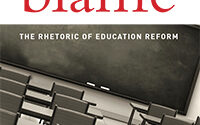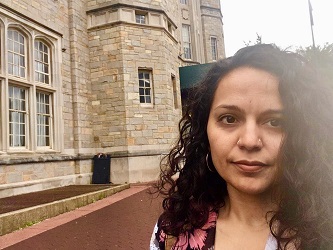Hate Crimes & the Contradictions of “Brownwashed” Conservatism
On February 22, 2017, two Indian engineers named Srinivas Kuchibhotla and Alok Madasani were having a drink at an Olathe, Kansas, sports bar. According to witnesses, a man named Adam Purinton approached the two men, asked their visa status, referred to them as “illegal migrants,” yelled “get out of my country,” and opened fire (Chaudhury). Kuchibhotla was killed, along with Ian Grillot, who tried to intervene to stop the killer. Purinton later admitted to shooting two “Iranian” people. The case was publicized worldwide as part of a spate of attacks targeting Black, Muslim, and Jewish people and institutions following Donald Trump’s 2016 election after a campaign mired in racism and xenophobia (“American”).
Chandrasekaran argues that Purinton’s assuming the men were from Iran “can hardly be coincidental.” Just weeks before the shootings, Iran had been named in Trump’s Executive Order 13769, commonly known as the Muslim Ban (“Executive”). Muslim people have without a doubt borne the brunt of racist and xenophobic post-9/11 and post-Muslim Ban attacks, infiltration, FBI setups, deportation, incarceration, and war. Islamophobia also impacts non-Muslims who are perceived to be Muslim; in April 2019, Isaiah Joel Peoples ran his car into a California crowd “because he thought at least some of them were Muslim” (Lin). In the weeks after the Kansas shooting, a white man shot a Sikh man in his driveway in Seattle, an Indian convenience store owner was shot in his front yard in South Carolina, and South Asians across the country faced racist slurs and attacks (Smiley, “A Murder”).
In this article, I consider the political ramifications of the Kansas shooting—specifically, a Republican politician’s uptake of Kuchibhotla’s widow, Sunayana Dumala, to support broadly anti-immigrant policies—as a form of rhetorical “brownwashing.” Ana Milena Ribero defines “brownwashing” as “a nationalist rhetorical strategy that cleanses the image of a discriminatory state through the inclusion of acceptable forms of heterogeneity,” reinforcing a “good migrant/bad migrant” binary. Writing during the Obama presidency, Ribero looks at how the Obama administration took up “good migrants” to target the Latinx voting bloc, while at the same time deporting millions of people. Racist violence is written into the deep structure of the US settler colonial state, and we cannot neatly periodize it within presidential administrations. That being said, the political context of the post-Trump era,1 particularly following the January 6, 2021, white supremacist attack on the Capitol, asks us to identify and deconstruct specific tactics of rhetorical “brownwashing” that extend beyond his administration. This case and its uptake also help us to situate current COVID-19-fueled anti-Asian hate crimes as part of a longer history of anti-Asian violence reinvigorated by Trumpism. “Brownwashed” conservatism in the aftermath of the Trump era2 reveals the contradiction between conservative understandings of “acceptable heterogeneity” and violent, racist acts that do not discriminate between different members of “heterogeneous” racialized peoples. Rhetorics of acceptable difference perpetuate ideologies that make racist, violent acts possible.
“Brownwashing” Conservatism through H-1B Visas
In the aftermath of the shootings, Kuchibhotla’s wife, Sunayana Dumala, faced deportation because she was no longer protected by her partner’s H-1B visa; she had relied on an H4 dependent visa (“Almost”).3 However, after Kansas state representative Kevin Yoder heard that Dumala faced difficulty returning to the US following Kuchibhotla’s funeral in Hyderabad, India, he advocated for her with immigration and customs and worked to get her a one-year visa to resume her marketing job (Smiley, “Almost”).4 He was quoted as saying, “[W]e are not going to deport the widow of the victim of a hate crime” (Smiley, “Almost”). He also chose Dumala to be his guest at Trump’s first State of the Union address. This provisional support of Dumala does not reflect a broadly pro-immigrant stance. Instead, his uptake of Dumala’s case can be understood as rhetorical strategy to distinguish himself from white-supremacist right-wing politics by positioning himself as “more accepting” of immigrants.
We can understand the white politician’s uptake of Dumala’s case as a form of “brownwashed conservatism” that upholds “highly skilled” immigrants and legislates against undocumented immigrants. In this case, Yoder’s welcoming rhetoric upholds the American Dream narrative of a non-Muslim, upwardly mobile engineer and his nuclear family.5 This echoes media reporting following the shooting; WIRED magazine ran a profile of Kuchibhotla, situating him in relation to the large population of Indian engineers in the US, detailing his Engineer of the Year nomination and the fact that after his death, the US Congress held a moment of silence (Smiley, “A Murder”). This trend in and of itself is not surprising; memorializing media rhetorics are sites in which national norms are reinscribed (Olwan) and model minorityist rhetorics of the “good immigrant” are reproduced (Kannan). Such rhetoric upholds embedded anti-Black logics, particularly the long history of mobilizing class- and caste-privileged Hindu South Asians in the US as “model minorities.” In The Karma of Brown Folk, for example, Vijay Prashad explains how during the Civil Rights and Black Power Movements, immigration policies privileging South Asians trained in STEM fields created a diasporic population that could serve as a racial wedge: “[t]he struggles of blacks [were] met with the derisive remark that Asians don’t complain; they work hard. . . . [T]hat some people of color achieve appreciable levels of success, for whatever reason, is used as evidence that racism poses no barrier to success” (7-8). Such model minorityist rhetoric is echoed around hate crimes and police brutality today. In the case of the Kansas shooting, media depictions of Kuchibhotla and Madasani stand in stark contrast to character-assassination media reporting following hate crimes and police brutality targeting Black people. After Trayvon Martin was murdered, Geraldo Rivera was quoted as saying that “the hoodie is as much responsible for Trayvon Martin’s death as George Zimmerman was,” warning parents that they should prohibit their children from wearing them (Weeks). After Michael Brown was murdered by cop Darren Wilson, the hashtag #IfTheyGunnedMeDown drew attention to media depictions of Brown as a “thug” flashing “gang signs” (Stampler). In both of these examples, not only is white supremacy left uninterrogated, but also Martin and Brown are held responsible for their own deaths.
Hate crimes like the Kansas shooting reveal the contradiction between the model minority myth’s false promise of assimilation into white America and the reality that model minorities are still racialized “others” in the context of white supremacy. In the case of the Kansas shooting, Yoder’s record on immigration reveals this contradiction. Yoder—who was supported by Donald Trump during Trump’s presidency—has called DACA unconstitutional, has backed the border wall, and, like many other Republicans, has been publicly in support of only “high-skilled immigrants.” By taking up Dumala’s case, Yoder has used her body to “brownwash” his immigration record. For example, in this video, Dumala introduces Yoder, who then situates Indians as uniquely persecuted by H-1B immigration laws.6 Further, on June 29, 2017, Yoder voted in favor of penalizing sanctuary cities that refused to cooperate with ICE; it is worth noting that this was after Kuchibhotla was murdered (“Kevin Yoder”). In contrast to cities pushing to protect undocumented immigrants, he introduced an immigration bill for high-skilled immigrants, which, he says, could help “people like Sunayana” (“Searching”). For Yoder, a pro-immigrant stance extends only to those who uphold the Asian model minority trope, and their provisional access to the US relies on bolstering ICE funding while defunding disaster relief. Specifically, Yoder championed legislation “that would make it easier for immigrants from India and China to obtain green cards for permanent legal status in the United States,” with the caveat that these immigrants’ green card application fees would be used to fund disaster relief, after he approved the transfer of $10 million from FEMA to Immigration and Customs Enforcement (Lowry). Without uncritically upholding FEMA (which has been widely criticized for its corruption and failure to meaningfully respond to the needs of post-Hurricane Katrina New Orleans), we can still critically interrogate what it means to defund relief programs slated for under-resourced communities impacted by hurricanes and other natural disasters in order to pour millions of dollars into the carceral state.
A pro-H-1B visa, pro-ICE stance cannot be conflated with a pro-immigrant stance. Yoder, however, has held tight to the narrative that his support for Dumala makes him a pro-immigrant candidate. In part, this points to the dramatic rightward turn of the Republican party, in which even Yoder’s wishy-washy policies read as progressive; for example, Yoder has been criticized by the party for pushing for backlogged work visas to be processed (Hanna, “Kansas”). As a spokesperson for Democrats, Sherice Davids of Kansas, puts it, Yoder “is trying to get away from [his voting record] by using one example and saying ‘See, but I’m not always this way’” (Hanna, “Kansas”).7 Yoder explained that he asked Dumala to be his guest at Trump’s State of the Union address “as a recognition for her tireless efforts to promote peace, and as a message to the Indian community that the United States is a nation of immigrants and they are welcome here”; he also said, “we had to let the world know that Kansas City, Kansas, and America are welcome to immigrants” (Londberg, “Sunayana”). In addition to attending the State of the Union address, Dumala also appeared in an ad for Yoder’s reelection (Hanna, “Congressman”).8 Yoder’s strategy was successful in securing a population of Indian voters in Kansas; for example, Brijpal Singh, chairman of the India Association of Kansas City, saw Yoder’s support for Dumala as “not only assur[ing] the Indian community but also send[ing] a strong message about the unstinted support from the elected representatives and administration towards the Indian community” (“Sunayana”).9
In this political context of brownwashing, Dumala was encouraged to safeguard herself against violence by allying with constructions of the “good immigrant.” This pressure is far from unique to her; her actions can be understood as part of a larger movement of self-identified “highly skilled” immigrants from India, some of whom agreed to pay larger green card processing fees to help fund Trump’s border wall (Raj). Chandrasekaran unpacks such promises of safety:
How do you get people whose bodies and families face existential peril to reinforce and reinscribe the very ideology that threatens them? One way is to stoke their need to perform a prescribed “Americanness”—to behave in ways and support views that visibly distinguish them—in order to build a visible racial “border wall” and secure (tentative) safety on the “inside.”
Yoder’s actions exemplify how the US state works to create resistant positionalities that are not in solidarity with the most marginalized but, instead, are about reinforcing a “good migrant/bad migrant” binary and securing protections for those with relatively privileged immigration status.10 This is, however, a false promise of safety; as Kuchibhotla’s murder and so many other murders and attacks demonstrate, people of color are being broadly conflated and targeted, and the existence of any “bad migrant” trope reinforces violence against all racialized peoples. The FBI estimates that there were 7,175 hate attacks against Muslims, Sikhs, Hindus, and other communities in 2017 alone (“2017”). Although Kuchibhotla and Madasani fit the profile of the “model minority engineer,” they were still targeted because of their skin color. While Kuchibhotla’s murder was treated differently in media than Black victims of police brutality, he was still killed. This analysis pushes us to not shame Dumala as an individual, but, instead, to critically understand the position she and many others are being put in, the mobilization of ”good migrant” to support “brownwashed” conservative political agendas, and the layered contexts in which we must fight white supremacy and anti-immigrant policies.
Conclusion
Yoder’s uptake of Dumala’s case shows that “brownwashing” conservative immigration policies and treating individual H-1B or H4 visa holders as exceptional is consistent with the “acceptably heterogeneous” logic of white supremacy. What is important is to understand how “brownwashing” is dividing and conquering communities that might otherwise be committed to identifying and dismantling logics, rhetorics, and material consequences of white supremacy. Yoder’s uptake of Dumala pushes us to develop critical rhetorical awareness of how our own bodies might be taken up in the service of white supremacist policies and of the rhetorical tactic of offering provisional safety within broadly racist, anti-immigrant political structures. Even as parts of our communities might seek alliance with Trumpism as a form of self-protection, these political alliances will not keep us safe from white supremacist violence.
Acknowledgements
Gratitude to Dhipinder Walia for her generative comments on the final draft of this article. Thanks to Shereen Inayatulla, Amy Wan, Andrea Efthymiou, and Jessica Yood for feedback on earlier drafts of this article. Finally, thank you to the two anonymous reviewers, who offered excellent feedback on my initial submission to Present Tense.
Endnotes
- This era includes many anti-Asian attacks fueled by the COVID-19 pandemic. return
- Trump strengthened ties with Indian Prime Minister Narendra Modi, widely criticized for his longstanding Islamophobic and caste-discriminatory policies (most recently, the CAA). It is important to pay attention to how Indians in the US are being taken up to “brownwash” conservatism and further racism and Islamophobia. return
- An H-1B visa applies to “nonimmigrant aliens” working in “specialty occupations,” such as those requiring a bachelor’s degree, designed “to help employers who cannot otherwise obtain needed business skills and abilities from the US workforce” (“H-1B Program”). An H4 visa is a dependent visa for the family members of H-1B visa holders (“H4 Visa”). Joe Biden announced in January 2021 that he would reverse Trump’s plan to ban these visas. return
- This is not long-term, stable employment. return
- This is consistent with Hindutva, right-wing Hindu nationalist movements in India that reinforce Hindu religious and cultural hegemony. The Hindu “right to belong” in US empire is often asserted through exclusivist and/or Islamophobic political and cultural formations (Therwath). This is not to erase important grassroots solidarity work, including #Asians4BlackLives, Desis Rising Up and Moving, and South Asia Solidarity Initiative; in this article, I focus on the institutional political uptake of these cases. return
- While this is outside the purview of this article, there is a significant gender gap in H-1B visas; nearly 3 out of 4 are Indian, and, within this, 1 in 4 is male. return
- Davids went on to defeat Yoder in the 2018 midterm elections. return
- Yoder ended his term in 2019. return
- See, for example, Iyer’s “Desi Wall of Shame.” As the recent “Howdy Modi” and “Namaste Trump” events in Texas and New Delhi demonstrate, #Hindus4Trump is still a strong political force. return
- South Asian feminist activists in the US who are specifically calling out the way caste privilege colludes with privileged immigration status and access to H1B visas (the majority of H1B visa holders in the US are Indian; “Three-fourths”). return
Works Cited
“2017 Hate Crime Statistics Released: Report Shows More Departments Reporting Hate Crime Statistics.” FBI, 13 Nov. 2018. www.fbi.gov/news/stories/2017-hate-crime-statistics-released-111318. Accessed 2 Apr. 2020.
“American Who Killed Indian Man in Kansas Bar Sentenced to Life.” Reuters, 5 May 2018. www.reuters.com/article/us-kansas-india/american-who-killed-indian-man-in-kansas-bar-sentenced-to-life-idUSKBN1I60LH. Accessed 2 Apr. 2020.
Chandrasekaran, Priya Rajalakshmi. “Unsettling ‘Indian American Hindus’ and Model Minority Projects in Trump-Era ‘America.’” Berkeley Journal of Sociology, 8 Sept. 2017. berkeleyjournal.org/2017/09/unsettling-indian-american-hindus-and-model-minority-projects-in-trump-era-america/. Accessed 2 Apr. 2020.
Chaudhury, Dipanjan Roy. “US Killer Asked Visa Status of Indians Before Shooting.” The Economic Times, 27 Feb. 2017. economictimes.indiatimes.com/nri/nris-in-news/us-killer-asked-visa-status-of-indians-before-shooting/articleshow/57363937.cms?from=mdr. Accessed 2 Apr. 2020.
Desi Wall of Shame. shameful.desi/. Accessed 2 Apr. 2020.
“Executive Order Protecting the Nation from Foreign Terrorist Entry into the United States.” WhiteHouse.gov, 27 Jan. 2017. www.whitehouse.gov/presidential-actions/executive-order-protecting-nation-foreign-terrorist-entry-united-states/. Accessed 2 Apr. 2020.
“H-1B Program.” U.S. Department of Labor. www.dol.gov/agencies/whd/immigration/h1b. Accessed 23 Feb. 2021.
“H4 Visa (Dependent Visa).” Path2USA. www.path2usa.com/h4-dependent-visa. Accessed 23 Feb. 2021.
Hanna, John. “Congressman Kevin Yoder’s Ad Features Sunaya Dumala, Widow of Slain Indian American Engineer Srinivas Kuchibhotla.” India West,11 Oct. 2018. www.indiawest.com/news/global_indian/congressman-kevin-yoder-s-ad-features-sunayana-dumala-widow-of/article_5c16264e-cd9d-11e8-bb22-77d8f4b0c356.html. Accessed 2 Apr. 2020.
—. “Kansas GOP Congressman’s Ad Has Softer Tone on Immigration.” Associated Press, 9 Oct. 2018. apnews.com/c21a97b994bb41d8aac3b6ab0bb9b53b. Accessed 2 Apr. 2020.
Kannan, Vani. “‘Model Minority’ or Potential Terrorist? Affective Economies, Rhetorics of Silence & the Murder of Sunando Sen.” Studies on Asia, vol. 4, no. 1, 2014, pp. 7–43. castle.eiu.edu/studiesonasia/documents/seriesIV/Kannan_studies_march14.pdf.
“Kevin Yoder.” Tracking Congress In the Age of Trump, n.d. projects.fivethirtyeight.com/congress-trump-score/kevin-yoder/. Accessed 2 Apr. 2020.
Lin, Rong-Gong. “Driver Crashed into People Because He Thought They Were Muslim, Police Say.” Los Angeles Times, 26 Apr. 2019. www.latimes.com/local/lanow/la-me-ln-isiah-peoples-sunnyvale-crash-crowd-muslim-20190426-story.html. Accessed 2 Apr. 2020.
Londberg, Max. “Sunaya Dumala of Olathe becomes Symbol of Hope for Immigrants at State of the Union.” The Kansas City Star, 30 Jan. 2018. www.kansascity.com/article197536584.html. Accessed 2 Apr. 2020.
Lowry, Bryan. “New Idea for Funding Hurricane Aid: Charge High-Tech Immigrants for Green Cards.” McClatchy DC, 12 Sept. 2018. www.mcclatchydc.com/news/politics-government/article218272755.html. Accessed 2 Apr. 2020.
Prashad, Vijay. The Karma of Brown Folk. Minneapolis: U of Minnesota P, 2000.
Raj, Yashwant. “For Faster Green Cards, Indian Techies Ready to Pay for Mexican Wall: Advocacy Group.” Hindustan Times, 4 Feb. 2018. m.hindustantimes.com/world-news/for-faster-green-cards-indian-techies-ready-to-pay-for-mexican-wall-advocacy-group/story-o1UMveDM1IgFvPExFOxdqO_amp.html. Accessed 2 Apr. 2020.
Smiley, Lauren. “A Murder Shatters the Dreams of Immigrant Tech Workers.” WIRED, 27 June 2017. www.wired.com/story/adam-purinton-shooting-olathe-kansas/. Accessed 23 Feb. 2021.
—. “After Srinivas Kuchibhotla’s Murder, His Widow Fights for Her Home.” WIRED, 22 Sept. 2017. www.wired.com/story/stricken-by-tragedy-an-immigrant-fights-for-her-home/. Accessed 2 Apr. 2020.
Stampler, Laura. “Twitter Users Ask What Photo Media Would Use #IfTheyGunnedMeDown.” Time Magazine, 11 Aug. 2014. time.com/3100975/iftheygunnedmedown-ferguson-missouri-michael-brown/. Accessed 2 Apr. 2020.
“Sunayana Dumala, Wife of Slain Techie Srinivas Kuchibhotla, Attends Donald Trump’s First State of the Union Address.” Firstpost, 31 Jan. 2018. www.firstpost.com/world/sunayana-dumala-wife-of-slain-techie-srinivas-kuchibhotla-attends-donald-trumps-first-state-of-the-union-address-4328607.html. Accessed 2 Apr. 2020.
Therwath, Ingrid. “Working for India or Against Islam? Islamophobia in Indian American Lobbies.” South Asia Multidisciplinary Research Journal, vol. 1, 2007, pp. 1-16.
“Three-fourths of H1B Visa Holders in 2018 are Indians: US Report.” Economic Times, 20 Oct. 2018. economictimes.indiatimes.com/nri/visa-and-immigration/three-fourths-of-h1b-visa-holders-in-2018-are-indians-us-report/articleshow/66289772.cms. Accessed 2 Apr. 2020.
Weeks, Linton. “Tragedy Gives the Hoodie a Whole New Meaning.” NPR, 24 Mar. 2012. www.npr.org/2012/03/24/149245834/tragedy-gives-the-hoodie-a-whole-new-meaning. Accessed 26 Apr. 2021.
COVER IMAGE CREDIT: “File:Say No to Xenophobia 1.jpg” by HelenOnline is licensed under CC BY-SA 4.0
KEYWORDS: hate crimes, South Asian diaspora, brownwashing, racism, white supremacy




 Vani Kannan, PhD, is an assistant professor of English at Lehman College, CUNY. Her research
interests include transnational/women-of-color feminisms, community literacies,
multimodal/multigenre composition, and social-justice-oriented writing pedagogies. Her work has
appeared in Writers: Craft & Context, Enculturation: A Journal of Rhetoric, Writing, and Culture,
Studies on Asia, and the edited collection The Political Turn in the Trump Era: Writing,
Democracy, Activism. Additionally, she has co-authored articles for Journal of Writing
Assessment, Community Literacy Journal, Reflections: Public Rhetoric, Civic Writing, and Service
Learning, Literacy in Composition Studies, and Journal of Academic Freedom.
Vani Kannan, PhD, is an assistant professor of English at Lehman College, CUNY. Her research
interests include transnational/women-of-color feminisms, community literacies,
multimodal/multigenre composition, and social-justice-oriented writing pedagogies. Her work has
appeared in Writers: Craft & Context, Enculturation: A Journal of Rhetoric, Writing, and Culture,
Studies on Asia, and the edited collection The Political Turn in the Trump Era: Writing,
Democracy, Activism. Additionally, she has co-authored articles for Journal of Writing
Assessment, Community Literacy Journal, Reflections: Public Rhetoric, Civic Writing, and Service
Learning, Literacy in Composition Studies, and Journal of Academic Freedom.